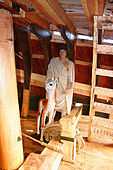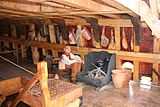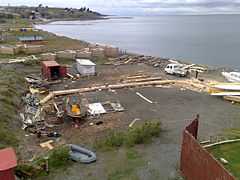| Museo Nao Victoria (Chile) |
|---|
|

Nao Victoria Replica in the Museum |
| Established |
2011 |
|---|
| Location |
Punta Arenas, Chile |
|---|
| Type |
Maritime Museum |
|---|
| Website |
http://www.naovictoria.cl/ |
|---|
The Nao Victoria Museum is located in Punta Arenas, Chile, and has been open to the public since 1 October 2011. The museum is private, the owner has received the Medal of the President of Chile for his work in promoting national identity during the celebrations for the bicentenary of the independence of the South American country.[1]
Spanish Vice Consul in Punta Arenas gave the entrepreneur the prize "Hispanic Identity" for the building of the Nao Victoria Replica.
[2]

A visitor dressed as a Spanish Conquistador, part of the interactive programs in the Museum
Aim of the Museo Nao Victoria
The museum's goal is to be interactive and offer its visitors the experience of interacting with replicas of the ships that contributed to the discovery of the area, colonization of the territory, or have a special and historic heritage significance for the Magallanes Region of Chile. The replicas were built using traditional shipbuilding techniques.
Collections
The main collection of the museum is the full-size replicas of historic ships on display along the Straits of Magellan. Replicas of weapons and ancient navigation tools are also exhibited as well as copies of documents and books relating to the historic ships and an outdoor shipbuilding workshop.
Replicas
Today the museum has three ship replicas:
Nao Victoria
Nao Victoria, was a carrack, 27 metres (89 ft) long, 7 metres (23 ft) wide, that was part of the fleet commanded by Ferdinand Magellan that discovered the waterway through the American continent. Later, commanded by Juan Sebastian Elcano, she was the only ship of the five to complete the first-time circumnavigation of the globe. Command by Duarte Barbosa, Nao Victoria participated in the Discovery of Chile as the first to explore the region in 1520, discovery or naming of Patagonia, Cape Virgenes, Straits of Magellan, Tierra del Fuego, the Pacific Ocean and other milestones.
She is one of the most famous ships in history of navigation.
| Nao Victoria |
|---|
| Replica of Nao Victoria, tourists on board. |
| Replica of Nao Victoria, Pablo, the first native American to be baptised in Chile. |
| Replica of Nao Victoria, Magellan in its cabin. |
| Replica of Nao Victoria, cook at the stove. |
|
James Caird
James Caird, was a lifeboat of the Endurance, adapted by Harry McNish, and sailed from Elephant Island to South Georgia during Sir Ernest Shackleton's 1916 Imperial Trans-Antarctic Expedition. Many historians consider the feat of the crew of James Caird to be the most impressive of all global navigation.
| James Caird |
|---|
| The replica of James Caird afloat in the river next to the Museum. |
| The replica of James Caird to the Strait of Magellan, with in the background the Tierra del Fuego. |
| The replica of James Caird in the workshop before being released in the Museum. |
| The replica of James Caird at the Museo Nao Victoria in winter with snow. |
|
Schooner Ancud
Ancud was the ship that, under an 1843 mandate of the President of Chile, Manuel Bulnes, claimed the Strait of Magellan on behalf of Chile's newly independent government, building Fort Bulnes. Commander of the schooner was Captain John Williams Wilson.
| Ancud |
|---|
| The replica of Ancud, bow, keel and stern, with in the background the Nao Victoria. |
| The replica of Ancud, complete hull structure. |
| Stern view of Ancud replica. |
|
HMS Beagle
HMS Beagle, a British Navy brig, was converted into exploration vessel. The most famous of her three trips was the second one under the command of Captain Fitz Roy. On board was the young Charles Darwin. HMS Beagle remained in the Magellan región for almost three years. She is famous for being the ship where Darwin started writing his theory of evolution. The construction of the full size HMS Beagle replica started in November 2012.[3]
| HMS Beagle |
|---|
| First cut for HMS Beagle's keel. |
| Keel, stem and stern of the 1:1 replica of the HMS Beagle ready for installation in Nao Victoria Museum of Punta Arenas |
| Nao Victoria standing over HMS Beagle's replica construction site |
| Starboard side view of the HMS Beagle's replica |
| State of the art of the HMS Beagle's replica building process as for march 20, 2013 |
| Completed hull of the 1:1 replica of the HMS Beagle is starting to be painted in Nao Victoria Museum in Punta Arenas |
|
Other collections
- Antique weapons – The replicas of historic ships are equipped with replicas of ancient firearms such as bombards, cannons, and muskets as well as handweapons like halberds, crossbows, and swords. All these weapons can be used by visitors.
- Ancient sailing instruments – In the different areas of the boats there are replicas of Astrolabes, Nocturnals, Quadrants, Jacob's staffs, Chip logs, and Hourglasss.
- Copies of original documents – The capitulation and instructions given by Emperor Charles V to Magellan and Ruy Faleiro, the accounts of the Atarazanas Reales de Sevilla on the expenditures and revenues of the expedition, the log of Francisco Albo, copy of Ginés de Mafra book, the de Moluccis Insular of Maximilianus Transylvanus, drawings from the book of Antonio Pigafetta, the map of Juan de la Cosa, the book Primaleon of Francisco Vasquez of Palmerin.
Shipbuilding workshop
On 31 December 2011, the museum announced the construction of two new replicas in its shipbuilding workshop:[4] the Schooner Ancud was opened to public on 5 September 2012. The Beagle replica is under construction.
During summer 2013 the shipbuilding workshop of the Museum built a one third size scale replica of an 18th-century galleon.[5]
| The 1:3 replica of a galleon of the eighteenth century |
|---|
| Figurehead of 1:3 scale replica of a Galleon built in Santiago by the Nao Victoria Museum Punta Arenas |
| Transom of 1:3 scale replica of a Galleon built in Santiago by the Nao Victoria Museum of Punta Arenas |
| Starboard view of a 1:3 scale replica of a Galleon built in Santiago by the Nao Victoria Museum of Punta Arenas |
|
See also
 Media related to Museo Nao Victoria (Chile) at Wikimedia Commons
Media related to Museo Nao Victoria (Chile) at Wikimedia Commons
References
External links
Coordinates: 53°06′28″S 70°52′47″W / 53.10768°S 70.879832°W / -53.10768; -70.879832
![]() Media related to Museo Nao Victoria (Chile) at Wikimedia Commons
Media related to Museo Nao Victoria (Chile) at Wikimedia Commons




















